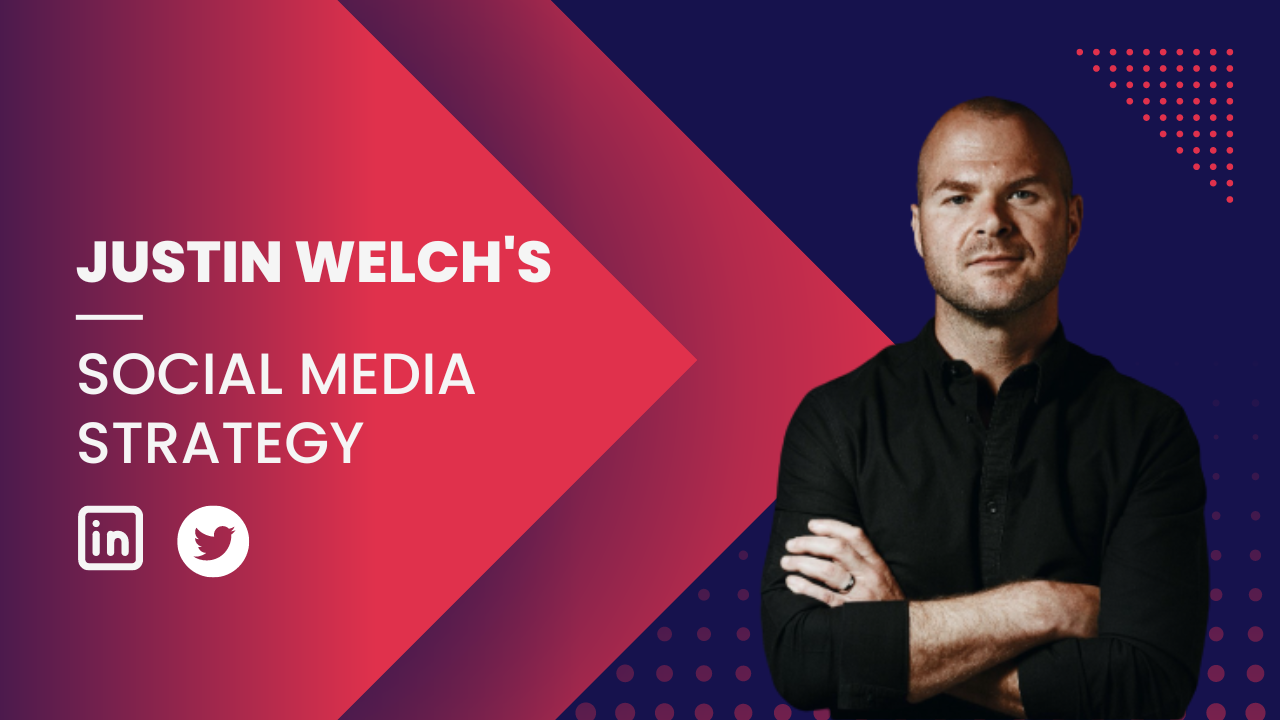In this case study, we will evaluate the Social Media Strategy implemented by Justin Welch that played a crucial role in scaling his business to $5 million in revenue.
Justin Welch, a former startup executive with a proven track record of building successful companies, has transitioned into the world of content creation and marketing.
With a substantial following on LinkedIn and Twitter, he has built a seven-figure one-person business using organic social media strategies.
This case study will explore the systematized Social Media Strategy he developed, known as the Content Operating System, which enabled him to consistently produce high-quality content, engage his audience, and drive revenue.
Background and Expertise:
Justin Welch is an experienced entrepreneur, startup executive, and advisor with an impressive resume.
Over the last decade, he has played a pivotal role in building two $50 million AR companies, leading teams of over 150 people, and raising over $300 million in venture capital.
Currently, he focuses on building a portfolio of one-person businesses, each generating revenue of up to $5 million.
Additionally, he serves as an advisor to early-stage SaaS companies and mentors entrepreneurs at various startups. As an LP at GTM fund, he invests $4 million per year into early-stage B2B SaaS companies.

The Importance of a Systematized Social Media Strategy:
A systematized Social Media Strategy is vital for achieving consistent and sustainable results in content marketing. Justin emphasizes that creators, like music artists or authors, should also employ systems for their content creation processes.
Systems provide a safety net for maintaining productivity and consistency, even when motivation is lacking. Justin’s goal is to bring the systems he learned in the business world into the realm of content creation.
The Content Operating System:
The Content Operating System developed by Justin Welch is a nine-step system designed to create a high volume of high-quality content for social media platforms.
This system serves as a hub and spoke model, with the hub being a long-form piece of content, such as a newsletter, and the spokes representing the various content pieces derived from the hub.

Step 1: Ideation
Ideation involves generating new ideas for a long-form piece of content. Justin dedicates an hour every Wednesday to searching for ideas across different mediums, including YouTube, newsletters, curated emails, Twitter, and LinkedIn. He collects these ideas in a centralized location, such as Notion or Google Drive, for easy access and reference.
Step 2: Research
After selecting an idea, Justin conducts research to gather additional insights and supporting information. He explores various sources, such as tweets, quotes, books, and articles, to enrich his understanding of the topic. All the collected research is stored in a document or platform, such as Notion, for later use.
Step 3: Writing the Long-Form Content
Using a template and a step-by-step approach, Justin writes the long-form content based on the selected idea and the gathered research.
He follows a structure that addresses the problem, agitates it, builds intrigue, presents a positive future, and provides a solution. Templates, such as those available in tools like Typeshare, assist in streamlining the writing process.
Step 4: Transforming Long-Form Content into Short-Form Content
The next step involves transforming long-form content into six different types of short-form content pieces.
These pieces include stories, observations, contrarian takes, listicles, past versus present comparisons, and tweet threads. Each short-form content piece is related to the central topic of the long-form content.
Step 5: Creating the Spokes
Justin crafts the spokes of his Social Media Strategy by developing individual pieces of content based on the short-form content types mentioned.
Step 5: Creating the Spokes (continued)
in Step 4. For each type of short-form content, Justin follows a specific format and structure to maximize engagement and relevance.
This includes leveraging storytelling techniques, sharing personal observations, presenting contrarian viewpoints, creating listicles, comparing past and present situations, and crafting tweet threads. By diversifying the content format, Justin ensures that his audience remains engaged and receives information in different ways.
Step 6: Scheduling and Publishing
Once the spokes are created, Justin schedules and publishes them on various social media platforms, including LinkedIn and Twitter.
He strategically plans the timing and frequency of his content to optimize reach and engagement. Justin emphasizes the importance of consistency and recommends adhering to a regular posting schedule.
Step 7: Engaging with the Audience
Engagement is a crucial aspect of Justin’s Social Media Strategy. He actively responds to comments, questions, and messages from his audience, fostering a sense of community and connection.
By engaging with his audience, Justin builds relationships, establishes credibility, and gains valuable insights for future content creation.
Step 8: Analyzing Performance
To evaluate the success of his Social Media Strategy, Justin analyzes key performance metrics. He tracks engagement rates, reach, click-through rates, and conversion rates to understand the effectiveness of his content and make data-driven decisions.
This analysis helps him identify high-performing content types, topics, and platforms, allowing him to refine and optimize his strategy over time.
Step 9: Iterating and Scaling
Based on the insights gained from performance analysis, Justin iterates and refines his Social Media Strategy continually.
He experiments with different content formats, topics, and distribution channels to identify what resonates best with his audience. As his business scales, he may consider delegating certain tasks to a team or exploring collaborations to expand his reach further.
Results and Impact:
Justin Welch’s systematized Social Media Strategy has yielded significant results, contributing to the scaling of his business to $5 million in revenue. By consistently producing high-quality content and engaging with his audience, he has built a substantial following on social media platforms.
This increased visibility and credibility have opened doors for consulting opportunities, partnerships, and speaking engagements. Justin’s Social Media Strategy has driven revenue and positioned him as a thought leader in the industry.
Key Takeaways:
- Systematizing content creation processes can provide consistency and productivity, even during periods of low motivation.
- Long-form content serves as the hub, while short-form content pieces act as spokes, maximizing the reach and impact of the original idea.
- Diversifying content formats keeps the audience engaged and allows for information consumption in different ways.
- Engaging with the audience fosters community, establishes credibility, and provides valuable insights for future content creation.
- Analyzing performance metrics helps make data-driven decisions and optimize Social Media Strategy over time.
- Continuous iteration and refinement are necessary to adapt to changing audience preferences and scale the business.
Conclusion
Justin Welch’s Social Media Strategy, known as the Content Operating System, has proven to be a successful approach in scaling his business to $5 million in revenue. By implementing a systematic approach to content creation, leveraging different content formats, and actively engaging with his audience.
Justin has achieved remarkable results and established himself as a prominent figure in the industry. This case study serves as an example of how a well-structured and disciplined Social Media Strategy can drive business growth and success in the digital age.


